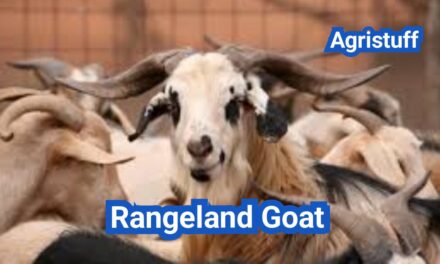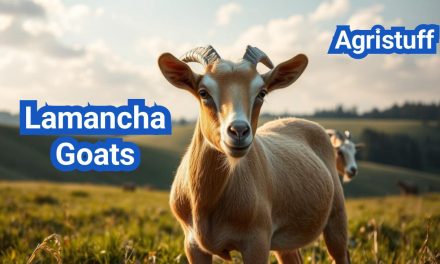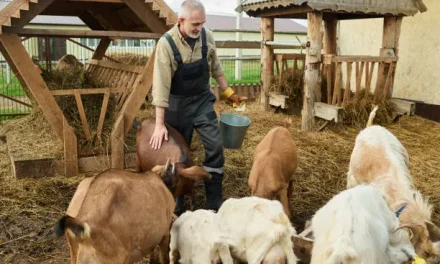As winter approaches, farmers across the United States must prepare their livestock facilities to protect their animals from harsh weather conditions. For those raising goats, having a well-designed barn is crucial for their health and well-being.
Proper ventilation, dry bedding, and adequate shelter are essential components of a goat barn plan. In regions with cold climates, winterization strategies are vital to ensure the barn remains a safe and healthy environment for the animals.
A well-planned goat barn not only safeguards the animals but also makes management tasks easier for farmers. By focusing on key elements such as ventilation, bedding, and winterization, farmers can create an optimal environment for their goats.
Key Takeaways
- Proper ventilation is crucial for maintaining a healthy environment in goat barns.
- Dry bedding is essential for preventing health issues in goats.
- Winterization strategies vary depending on the U.S. climate region.
- A well-designed barn plan improves overall goat care and management.
- Regional climate considerations are vital for effective goat barn winterization.
Understanding Goat Housing Needs Across U.S. Climate Zones
The diverse climate conditions across the United States present unique challenges for goat owners in providing suitable housing. Goat barn ideas and designs must take into account the regional climate challenges to ensure the health and well-being of the animals.
Regional Climate Challenges for Goat Owners
Different regions in the U.S. face various climate-related issues. For instance, areas with cold winters require goat housing that provides adequate insulation and protection from harsh weather conditions. In contrast, regions with hot summers need goat barns designed to offer sufficient shade and ventilation.
Climate challenges can be broadly categorized into cold climates, hot climates, and areas with high precipitation. Each category demands specific considerations for goat housing.
Seasonal Adaptations Required
Goat owners must adapt their goat housing to the changing seasons. This includes ensuring proper ventilation during hot months and providing additional insulation during colder periods. Seasonal adaptations are crucial for maintaining a healthy environment for goats.
- Summer: Provide shade and ventilation
- Winter: Ensure insulation and draft prevention
- Spring/Autumn: Adjust ventilation according to temperature fluctuations
Minimum Shelter Requirements by Breed
Different goat breeds have varying shelter requirements based on their origin and adaptation. For example, breeds originating from colder climates may require more robust shelter, while those from warmer regions may need more emphasis on ventilation.
Understanding the breed-specific shelter needs is essential for providing optimal care. Goat owners should research the specific requirements of their breeds to design appropriate housing.
| Breed Origin | Primary Shelter Needs |
|---|---|
| Cold Climates | Insulation, Draft Prevention |
| Warm Climates | Ventilation, Shade |
Essential Elements of an Effective Goat Barn

Creating a functional goat barn involves understanding the specific needs of your goats and the local environment. An effective goat barn is more than just a shelter; it’s a crucial component of your goat farm that directly impacts the health, productivity, and overall well-being of your goats.
Space Requirements Per Goat
When designing a goat barn, one of the critical factors to consider is the space requirement per goat. Adequate space is essential for the health and comfort of your goats. A general rule of thumb is to provide at least 15-20 square feet per goat inside the barn. However, this can vary depending on the breed, size, and age of your goats.
Adequate space allows goats to stand, turn around, and lie down comfortably. It also helps in reducing stress and aggression among the goats. For kidding pens, additional space is necessary to accommodate the doe and her kids.
Basic Structural Components
The structural integrity of your goat barn is paramount. The barn should be constructed with durable materials that can withstand local weather conditions. Key components include a sturdy frame, appropriate roofing, and walls that provide adequate protection from the elements.
Roofing materials should be chosen based on durability and insulation properties. Metal roofs are popular for their durability, but they can get hot in the summer. Ensuring proper insulation and ventilation can help mitigate this issue.
Safety and Predator Protection Features
Protecting your goats from predators is a critical aspect of goat barn design. Common predators include coyotes, foxes, and birds of prey. The barn should be designed with secure fencing, strong doors, and covered windows to prevent predator entry.
Hardware cloth is recommended over chicken wire for fencing because it’s more durable and difficult for predators to tear. Additionally, electric fencing can be an effective deterrent against predators.
- Use sturdy materials for construction
- Ensure all openings are securely covered
- Install strong doors and locks
By focusing on these essential elements, you can create a goat barn that is both functional and safe for your goats.
Planning Your Goat Barn: Size and Layout Considerations
The size and layout of your goat barn are crucial factors that directly impact the well-being of your goats. A well-designed barn ensures that your goats have enough space to move comfortably, reducing stress and promoting overall health.
Determining Appropriate Barn Size
To determine the appropriate size for your goat barn, consider the number of goats you have, their breed, and their age. A general rule of thumb is to provide at least 15-20 square feet per goat inside the barn. However, this can vary depending on the size and breed of the goats. For example, larger breeds like Boer goats require more space than smaller breeds like Nigerian Dwarfs.
Key factors to consider when sizing your goat barn include:
- The number of goats you plan to keep
- The size and breed of your goats
- The need for separate areas for different goat groups (e.g., kids, pregnant does, bucks)
- Space for feeding and milking stations
- Adequate ventilation and airflow
Optimal Layout for Goat Movement
An optimal layout for goat movement involves creating a flow that allows goats to move freely without congestion. This includes designing pathways that lead to feeding areas, milking stations, and outdoor spaces. The layout should also consider the natural behavior of goats, such as their tendency to climb and their social structure.
Efficient layout features include:
- Wide, unobstructed pathways
- Elevated areas for goats to climb and observe their surroundings
- Separate areas for different activities (e.g., feeding, resting, milking)
Accommodating Different Goat Groups
Accommodating different goat groups within your barn is essential for reducing stress and preventing disease transmission. This can be achieved by creating separate pens or areas for different groups, such as kids, pregnant does, and bucks.
Considerations for accommodating different goat groups include:
- Separate pens for kids to prevent them from being trampled or bullied
- Quarantine areas for new or sick goats
- Areas for pregnant does or does with kids
Popular Goat Barn Designs for U.S. Farms

The diverse climate zones across the United States necessitate a range of goat barn designs, from simple shelters to complex barns. Farmers across the country are adopting various designs that cater to their specific needs, climate conditions, and the size of their operations.
Three-Sided Shelter Designs
Three-sided shelters are a popular choice among goat farmers due to their simplicity and effectiveness. These structures provide protection from prevailing winds and rains while allowing for natural ventilation. The open side should face away from the prevailing winds to ensure the interior remains dry and comfortable for the goats.
Fully Enclosed Barn Options
Fully enclosed barns offer comprehensive protection from the elements and predators. They are particularly beneficial in harsh climates or for farms with valuable or vulnerable goat breeds. These barns require careful planning to ensure adequate ventilation and prevent moisture buildup.
Convertible and Modular Designs
Convertible and modular goat barn designs offer flexibility, allowing farmers to adjust the structure as their herd size changes or as new needs arise. These designs can be particularly cost-effective in the long run, as they reduce the need for entirely new structures.
Regional Design Adaptations
Regional adaptations play a crucial role in the effectiveness of goat barn designs. For instance, barns in colder climates may require additional insulation and draft prevention measures, while those in hotter climates may need enhanced ventilation systems. Understanding local climate conditions is key to designing an effective goat barn.
By considering these popular goat barn designs and adapting them to their specific regional and operational needs, U.S. farmers can create optimal living conditions for their goats, enhancing overall farm productivity and animal welfare.
Goat Barn Ventilation Systems and Strategies
Goat barn ventilation plays a vital role in preventing respiratory issues and maintaining a comfortable environment for the animals. Effective ventilation is critical for removing moisture, reducing ammonia levels, and preventing the buildup of pathogens that can harm your goats.
Natural Ventilation Techniques
Natural ventilation is a cost-effective and energy-efficient way to ventilate your goat barn. Techniques include:
- Using windows and doors to control airflow
- Incorporating vents and ridge caps to enhance natural airflow
- Designing the barn to take advantage of prevailing winds
By carefully planning the layout and design of your goat barn, you can maximize natural ventilation and reduce the need for mechanical systems.
Mechanical Ventilation Options
In some cases, natural ventilation may not be sufficient, especially in larger barns or during extreme weather conditions. Mechanical ventilation options include:
- Exhaust fans to remove stale air and moisture
- Fresh air inlets to bring in clean air
- Automated systems that adjust ventilation rates based on temperature and humidity
These systems can be particularly useful during hot summer months or in barns with high stocking densities.
Balancing Airflow and Draft Prevention
While ventilation is crucial, it’s equally important to prevent drafts that can chill your goats. Strategies for balancing airflow and draft prevention include:
- Using baffles or curtains to direct airflow
- Installing ventilation systems that can be adjusted seasonally
- Ensuring that ventilation openings are not directly opposite each other
By striking the right balance, you can maintain a healthy environment without compromising the comfort of your goats.
Seasonal Ventilation Adjustments
Ventilation needs change with the seasons. In winter, the focus is on removing moisture and maintaining air quality without causing drafts. In summer, the goal is to maximize airflow to keep the barn cool. Adjustments include:
- Reducing ventilation rates in winter to conserve heat
- Increasing ventilation rates in summer to enhance cooling
- Using seasonal curtains or covers to control airflow
By adapting your ventilation strategy to the changing seasons, you can ensure that your goat barn remains a healthy and comfortable environment for your animals year-round.
Comprehensive Goat Barn Bedding Systems

Goat barn bedding systems play a vital role in ensuring a clean and healthy environment for your herd. The right bedding material and management strategy can significantly impact goat health, barn cleanliness, and overall farm efficiency.
Comparing Bedding Materials
Choosing the appropriate bedding material is crucial for maintaining a dry and comfortable environment for your goats. Common bedding materials include straw, hay, wood shavings, and sand. Each material has its advantages and disadvantages.
| Bedding Material | Absorbency | Comfort | Cost |
|---|---|---|---|
| Straw | High | Good | Moderate |
| Wood Shavings | High | Excellent | High |
| Sand | Low | Good | Low |
The choice of bedding material depends on factors such as availability, cost, and the specific needs of your goats.
Deep Litter Bedding Management
Deep litter bedding is a popular management strategy that involves allowing the bedding material to accumulate over time, creating a composting layer. This method requires careful management to maintain a healthy environment.
Key considerations for deep litter bedding management include:
- Regular stirring to aerate the bedding and promote composting
- Monitoring moisture levels to prevent the buildup of harmful pathogens
- Adding new bedding material as needed to maintain depth and dryness
Cleaning Frequency and Methods
The frequency and method of cleaning the goat barn depend on several factors, including the size of the barn, the number of goats, and the bedding material used.
General guidelines for cleaning frequency:
- Daily removal of soiled bedding and manure
- Weekly or bi-weekly thorough cleaning of the barn, depending on the depth of the bedding
- Regular disinfection of feeding and watering areas
Bedding Considerations for Different Seasons
Seasonal changes can impact the bedding needs in your goat barn. During colder months, additional bedding may be required to keep goats warm and dry. In warmer months, ensuring adequate ventilation and managing moisture levels becomes more critical.
By understanding the different bedding materials, management strategies, and seasonal considerations, you can create a comprehensive goat barn bedding system that promotes the health and well-being of your goats.
Winterizing Your Goat Barn for Cold Climates

Preparing your goat barn for winter involves several key strategies to ensure the comfort and safety of your goats. As the temperature drops, it’s crucial to create a warm and dry environment that protects your animals from harsh weather conditions.
Insulation Strategies and Materials
Proper insulation is vital for maintaining a warm and stable temperature within the goat barn. Effective insulation materials include straw, hay, or specialized insulation products designed for barns. When choosing insulation, consider factors such as cost, availability, and the specific climate conditions of your area.
“Insulation is key to keeping your goat barn warm during the winter months,” says Jane Smith, a seasoned goat farmer. “We use a combination of straw and foam board to keep our barn cozy.”
Draft Prevention Techniques
Drafts can significantly compromise the warmth of your goat barn. To prevent drafts, inspect your barn for any gaps or openings and seal them using appropriate materials like caulk or weatherstripping. Windows and doors are common areas where drafts occur, so ensure they are well-sealed and consider adding storm windows for extra protection.
- Seal gaps around windows and doors
- Use weatherstripping to prevent air leaks
- Install storm windows for added protection
Heat Sources and Temperature Management
In extremely cold climates, supplemental heat sources may be necessary to maintain a comfortable temperature within the goat barn. Options include electric heaters, propane heaters, or heat lamps. However, it’s essential to use these safely to avoid fire hazards. Monitor the temperature closely and adjust your heating strategy as needed to maintain a stable environment.
| Heat Source | Safety Considerations |
|---|---|
| Electric Heaters | Keep away from flammable materials |
| Propane Heaters | Ensure proper ventilation to avoid carbon monoxide buildup |
| Heat Lamps | Securely mount to prevent them from being knocked over |
Water Systems for Freezing Conditions
Ensuring access to unfrozen water is critical for the health of your goats during winter. Consider using heated water buckets or waterers designed to prevent freezing. Regularly check the water supply to ensure it’s functioning correctly and that your goats have continuous access to fresh water.
By implementing these strategies, you can effectively winterize your goat barn and provide a safe and comfortable environment for your goats during the cold winter months.
Building a Predator-Proof Goat Barn

Predator protection is an essential aspect of managing a goat farm or homestead effectively. Goat owners must be proactive in safeguarding their animals from various predators that can threaten their herd’s safety and well-being.
Common Predators by U.S. Region
Different regions in the United States have different predator species that goat owners need to be aware of. For instance, in the western states, mountain lions and coyotes are common predators, while in the southeastern states, coyotes and wild dogs are more prevalent.
- Western U.S.: Mountain lions, coyotes, bobcats
- Southeastern U.S.: Coyotes, wild dogs, bobcats
- Northeastern U.S.: Coyotes, foxes, bears
Secure Fencing and Gate Systems
A well-designed fencing system is crucial for keeping predators out. The fence should be at least 6 feet tall and made of sturdy materials like high-tensile wire or chain link. The mesh size should be small enough to prevent predators from getting through.
When it comes to gate systems, they should be equally secure. Gates should be made of the same material as the fence and should fit tightly to prevent any gaps.
Nighttime Protection Measures
Nighttime is when predators are most active, so extra precautions are necessary. This includes using motion-sensitive lighting around the barn and fencing areas to deter predators. Additionally, ensuring that the barn is well-constructed and secure can provide a safe haven for goats during the night.
- Use motion-sensitive lights around the perimeter.
- Keep the barn doors and windows securely closed.
- Consider using guard animals (discussed below).
Guardian Animal Integration
Guardian animals, such as livestock guardian dogs (LGDs), can be an effective way to protect goats from predators. These dogs are bred to guard and protect livestock and can be a valuable addition to any goat farm.
When integrating guardian animals, it’s essential to introduce them to the goat herd gradually and under controlled circumstances to ensure a harmonious and effective protective relationship.
Specialized Areas Within Your Goat Barn

A well-designed goat barn incorporates various specialized areas to enhance goat care and management efficiency. These areas are crucial for the health, safety, and productivity of the goats.
Designing Effective Kidding Pens
Kidding pens are essential for the health and safety of both the mother and newborn kids. These pens should be designed to be easily accessible, well-ventilated, and draft-free. Proper kidding pen design includes adequate space for the doe and her kids, typically around 16 to 25 square feet per doe.
To create an effective kidding pen, consider using individual stalls or pens within the barn. These should be equipped with adequate bedding and be easily cleanable. The pens should also be designed to minimize stress on the doe and her kids.
Feed Storage and Distribution Areas
Proper feed storage is critical to maintaining the quality of the feed and preventing waste. The feed storage area should be dry, well-ventilated, and protected from pests. Consider using rodent-proof containers or bins to store feed.
The distribution area should be designed for easy access to feed for both the goats and the farmer. This may include using feeders that minimize waste and are easy to clean.
Milking Station Considerations
For dairy goat operations, a well-designed milking station is essential. The milking area should be clean, well-lit, and easily accessible. Consider the size of the milking stand and the space needed for milking equipment.
The milking station should also be designed with sanitation in mind, including easy-to-clean surfaces and adequate drainage. Proper ventilation is also crucial to prevent the buildup of odors and moisture.
Quarantine and Medical Treatment Spaces
A quarantine area is vital for isolating new or sick goats to prevent the spread of disease. This area should be separate from the main goat area and have its own ventilation system to prevent cross-contamination.
The medical treatment area should be equipped with necessary supplies and be easily accessible. Consider including a separate area for storing medications and a designated space for treating sick goats.
DIY Goat Barn Construction: Step-by-Step Guide
With the right tools and materials, creating a DIY goat barn is an achievable project for any goat owner looking to provide quality housing. This guide will walk you through the essential steps to construct a safe and functional goat barn.
Tools and Materials Needed
Before starting your DIY goat barn construction, it’s crucial to gather all the necessary tools and materials. This includes lumber for framing, roofing materials, nails, a hammer, saw, drill, and safety gear.
- Lumber (2x4s, 2x6s) for framing
- Roofing materials (corrugated metal, shingles)
- Nails and screws
- Hammer and saw
- Drill and bits
- Safety gear (gloves, goggles)
Foundation and Framing Process
The foundation and framing are critical components of your goat barn. Start by laying out the foundation, ensuring it’s level and secure. Then, construct the frame using your lumber.
| Step | Description |
|---|---|
| 1 | Mark out the foundation area |
| 2 | Lay the foundation (concrete, gravel) |
| 3 | Construct the frame |
Roofing and Drainage Systems
A proper roofing system is vital for protecting your goats from the elements. Choose a suitable roofing material and ensure it’s installed correctly to prevent leaks. Additionally, consider the drainage system to keep the area around your barn dry.
Wall Construction and Finishing
Once the frame and roof are in place, you can start constructing the walls. Use sturdy materials to ensure the barn is secure and draft-free. Finish the interior with appropriate bedding and ensure good ventilation.
By following these steps and using the right materials, you can create a DIY goat barn that provides a safe and healthy environment for your goats.
Budget-Friendly Goat Barn Solutions

With a little creativity, you can construct a functional goat barn without overspending. Building on a budget requires exploring various cost-effective strategies that don’t compromise the quality and safety of the barn.
Repurposed Materials Options
One of the most effective ways to save on goat barn construction is by using repurposed materials. Old pallets, discarded lumber, and salvaged metal can be transformed into a sturdy barn. Not only does this approach reduce waste, but it also significantly cuts down on material costs.
Examples of repurposed materials include:
- Old shipping pallets for walls and fencing
- Salvaged wood for roofing and flooring
- Discarded metal sheets for roofing
Pallet Construction Techniques
Pallet construction is a popular method for building budget-friendly goat barns. Pallets are readily available, often for free or at a low cost. They can be used to create the frame, walls, and even the roof of the barn.
Key pallet construction tips:
- Ensure pallets are sturdy and in good condition
- Use a solid foundation to prevent rotting
- Secure pallets tightly to withstand weather conditions
Phased Building Approaches
For many goat owners, building a barn is a process that occurs in phases. Starting with the essentials and gradually adding more features as resources become available is a practical approach.
Phased building steps:
- Initial shelter construction
- Adding fencing and enclosures
- Incorporating feeding and milking areas
Cost-Saving Community Resources
Leveraging community resources can significantly reduce the cost of goat barn construction. This includes seeking out free or low-cost materials, labor assistance from local volunteers, or guidance from experienced builders.
Community resources to explore:
- Local online forums and social media groups
- Farmers’ markets and agricultural events
- Community bulletin boards and local classifieds
Small-Scale Goat Barn Designs for Limited Space

In urban and suburban settings, goat barn design must adapt to available space constraints. As the popularity of small-scale goat farming grows, even in limited spaces, farmers are looking for innovative ways to house their goats efficiently.
Compact Layouts for 2-4 Goats
Designing a compact goat barn for 2-4 goats requires careful consideration of space utilization. A well-planned layout can provide ample room for the goats to move while keeping the overall footprint small. For instance, a rectangular barn with dimensions of 8×12 feet can comfortably accommodate 3 goats, providing enough space for movement and basic amenities.
“The key to a successful small goat barn is maximizing vertical space while ensuring the structure remains sturdy and safe for the animals,” says Jane Smith, a seasoned goat farmer. “By doing so, you can create a functional area that meets the needs of both the goats and the farmer.”
Vertical Space Utilization
Utilizing vertical space is crucial in small goat barn designs. By building upwards, farmers can create additional storage for hay and bedding, keeping the floor clear and reducing clutter. Loft areas can also serve as additional living space for the goats or storage for equipment.
- Install loft areas for additional space or storage.
- Use wall-mounted feeders and watering systems to save floor space.
- Incorporate vertical fencing to maximize outdoor enclosure space.
Combination Structures with Chickens
Combining goat housing with chicken coops is a practical solution for small farms. This approach not only saves space but also allows for a more diverse and resilient farming operation. When designing a combination structure, it’s essential to consider the different needs of goats and chickens, such as separate areas for feeding and roosting.
For example, a barn can be divided into sections, with goats housed in one area and chickens in another, sharing a common wall for efficiency. This setup can also facilitate easier management and monitoring of both species.
Urban and Suburban Considerations
In urban and suburban areas, additional considerations come into play when designing a goat barn. Noise reduction, odor control, and visual appeal become important factors due to closer proximity to neighbors. Using sound-absorbing materials and designing the barn with aesthetics in mind can help mitigate potential issues.
Moreover, checking local zoning regulations is crucial before constructing a goat barn in these areas. Some municipalities have specific requirements or restrictions on keeping livestock in residential zones.
Maintaining Your Goat Barn Through Seasons

Effective goat barn maintenance involves daily routines and seasonal checks. Maintaining a goat barn is an ongoing task that requires attention throughout the year to ensure the health and well-being of the goats. This involves a combination of daily maintenance routines, seasonal inspections, managing odors and pests, and establishing repair and replacement schedules.
Daily Maintenance Routines
Daily maintenance is crucial for keeping the goat barn clean and hygienic. This includes removing soiled bedding, cleaning feeding and watering areas, and ensuring that the barn is well-ventilated.
- Remove soiled bedding daily to prevent the buildup of harmful bacteria and odors.
- Clean feeding and watering areas to prevent contamination.
- Check ventilation systems to ensure proper airflow.
Seasonal Inspection Checklist
Conducting seasonal inspections helps identify potential issues before they become major problems. Inspect the barn’s structure, roofing, and fencing, and check for signs of wear and tear.
| Season | Inspection Tasks |
|---|---|
| Spring | Inspect for winter damage, check fencing, and ensure drainage is clear. |
| Summer | Check ventilation, inspect for signs of heat stress, and ensure adequate shading. |
| Autumn | Prepare for winter by insulating pipes, checking roofing, and stocking up on bedding. |
| Winter | Monitor temperature, ensure adequate bedding, and check for drafts. |
Odor and Pest Management
Managing odors and pests is essential for maintaining a healthy environment. This can be achieved through regular cleaning, proper ventilation, and using pest control measures.
Effective Strategies:
- Regularly clean and disinfect areas where goats eat and drink.
- Use proper ventilation to reduce odors and prevent moisture buildup.
- Implement pest control measures such as traps or repellents.
Repair and Replacement Schedules
Establishing a schedule for repairs and replacements helps maintain the barn’s integrity. Identify areas that need frequent attention and plan accordingly.
Adapting Commercial Goat Barn Kits to Your Needs
For many goat owners, commercial goat barn kits present a convenient and efficient solution for housing their animals. These kits are designed to be adaptable to various needs and climates, making them an attractive option for farmers across different regions.
Evaluating Pre-Fabricated Options
When considering a commercial goat barn kit, it’s essential to evaluate the components and features included. Pre-fabricated kits usually come with pre-cut lumber, roofing materials, and hardware, which can simplify the construction process. Look for kits that offer durability and resistance to weather conditions.
The quality of materials and construction should be a top priority. Check if the kit includes features like ventilation systems, feeding areas, and predator protection.
Customization Possibilities
While commercial goat barn kits are pre-designed, many offer customization options to suit specific needs. This might include adding extra stalls, modifying the layout, or incorporating additional features like windows or doors.
Consider the potential for expansion or modification in the future. A kit that allows for flexibility can be more cost-effective in the long run.
Installation Considerations
Before purchasing a kit, assess the installation requirements. Some kits may require specialized tools or skills, while others are designed for DIY installation.
Consider the terrain and site preparation needed for the barn. Ensure that the kit is suitable for your land and climate conditions.
Cost Comparison with DIY Construction
One of the significant advantages of commercial goat barn kits is their potential cost-effectiveness compared to DIY construction. However, it’s crucial to conduct a thorough cost comparison, including materials, labor, and any additional features.
| Cost Factor | Commercial Kit | DIY Construction |
|---|---|---|
| Materials | Included in kit price | Variable costs for materials |
| Labor | Potential for self-installation | Labor costs for construction |
| Additional Features | Some kits offer customization | Additional costs for custom features |
By carefully evaluating these factors, goat owners can make an informed decision about whether a commercial goat barn kit is the right choice for their needs.
Creating the Ideal Goat Barn for Your Herd
Creating an ideal goat barn involves careful consideration of your herd’s specific needs, the local climate, and your management practices. Effective goat barn planning is crucial for ensuring the health and well-being of your goats.
A well-designed barn provides a safe and healthy environment, protecting your goats from predators and harsh weather conditions. The barn design should incorporate proper ventilation, adequate bedding, and suitable space for your goats to move comfortably.
By considering factors such as climate, breed, and management practices, you can create a goat barn that meets your needs and promotes the health and productivity of your herd. Proper goat care starts with a well-planned barn, and investing time in designing the ideal goat barn will pay dividends in the long run.
Ultimately, the ideal goat barn is one that balances functionality with the needs of your goats, providing a healthy and thriving environment for years to come.
FAQ | Goat Barn
What are the key considerations for designing a goat barn?
The key considerations include sufficient space for the goats, basic structural integrity, features to safeguard against predators, and adequate ventilation and bedding systems.
How do I determine the appropriate size for my goat barn?
To determine the size, consider the number of goats you have, their breed, and the space needed for movement and separate areas for different groups if necessary.
What are the benefits of using deep litter bedding in a goat barn?
Deep litter bedding can help reduce waste, provide insulation, and create a dry environment for the goats, but it requires regular management to maintain cleanliness and prevent odor buildup.
How can I winterize my goat barn for cold climates?
Winterizing involves insulation techniques, preventing drafts, managing heat sources, and ensuring access to water in freezing conditions to protect the health and well-being of your goats.
What are some effective ventilation strategies for goat barns?
Effective ventilation strategies include natural ventilation techniques, such as windows and vents, and mechanical ventilation options, like fans, to balance airflow and prevent drafts.
How can I make my goat barn predator-proof?
To make your goat barn predator-proof, consider secure fencing and gate systems, nighttime protection measures, and the integration of guardian animals to safeguard against common predators.
What are some budget-friendly solutions for building a goat barn?
Budget-friendly solutions include using repurposed materials, pallet construction techniques, phased building approaches, and leveraging community resources to save costs.
Can I combine goat housing with other animals, like chickens?
Yes, you can combine goat housing with other animals, but it’s essential to consider the unique needs and challenges of each species to ensure a harmonious and healthy environment.
How often should I clean and maintain my goat barn?
Regular daily maintenance routines, seasonal inspections, and a schedule for repairing and replacing components are crucial to maintaining a clean, safe, and healthy environment for your goats.
Are commercial goat barn kits a viable option for me?
Commercial goat barn kits can be a convenient solution, but it’s essential to evaluate the options, consider customization possibilities, and assess installation requirements and costs compared to DIY construction.
What are some essential features to include in my goat barn design?
Essential features include kidding pens, feed storage and distribution areas, milking stations, and quarantine and medical treatment spaces to enhance goat care and barn management.
How can I utilize vertical space in a small goat barn?
Utilizing vertical space can be achieved through the use of loft areas for storage or additional goat housing, and installing shelves or hanging systems for equipment and supplies.
Conclusion of: Goat Barn Plans
Introduction: what a goat barn must do in U.S. climates
A well-designed goat barn is the backbone of a healthy herd in the United States, where weather can swing from frozen blizzards to humid heat waves depending on your state. The goal of any goat barn plan is simple: keep goats dry, give them fresh air without chilling drafts, and create a layout that makes feeding, cleaning, and kidding easy for you. Goats handle cold far better than dampness, so moisture control is priority one, while ventilation and bedding do the heavy lifting year-round. USDA-NRCS livestock shelter planning basics
Pick a goat barn style that matches your regional climate
Your goat barn can be a three-sided run-in shed, a pole barn with adjustable curtains, or a fully enclosed structure with fans, and the “right” choice depends on climate and how many hours goats spend inside. In drier parts of the West, open-front goat barn plans work well because airflow is naturally high and precipitation is low. In the Upper Midwest, Northeast, or Pacific Northwest, a more enclosed goat barn with controllable openings is safer because wind-driven snow and rain can soak bedding fast. Whatever style you choose, aim for flexibility—open it up in summer, tighten it down in storms. Oklahoma State guide to goat housing options
Choose a high, well-drained site and orient the goat barn correctly
The best goat barn sits on high, well-drained ground. If water flows toward the building, you will fight mud, ammonia, and parasites no matter how much bedding you add. Choose a gentle slope that carries runoff away and consider a gravel pad at entrances. For most U.S. locations, orient the goat barn opening to the south or southeast for winter sun while putting the solid wall into the prevailing cold wind. This setup cuts drafts at goat level and helps sunlight dry the interior after storms. UMass extension on goat barn siting and orientation
Size the goat barn for comfort, not just minimums
Crowding is one of the quickest ways to turn a goat barn into a disease factory. A practical target is around 10–15 square feet per adult goat in bedded housing, and closer to 15–20 square feet per adult if goats are confined for long periods. Add a yard or dry lot of roughly 20–30 square feet per goat so they can move, browse, and avoid pecking-order stress. Wider alleys (4–5 feet) prevent bottlenecks when you move animals, and they make barn work easier with wheelbarrows or small equipment. Purdue recommendations for goat barn space
Plan a simple interior layout that saves labor
A smart goat barn layout follows your daily routine. Create a sleeping/bedded zone that stays clean, a feed alley where hay can be dropped without goats trampling it, and a water area with drainage so spills don’t soak bedding. Include a small sorting alley or gates so you can separate kids, bucks, or thin does quickly. If you milk, plan a clean transition area where goats can be brushed or udders wiped before entering the parlor. Good flow inside the goat barn reduces time and stress for both goats and people. NRCS layout ideas for goat handling areas
Use tough, goat-proof materials in the goat barn
Goats chew wood, rub posts, and test every weak point, so a goat barn needs sturdier materials than a typical shed. Treated posts, metal siding, and protected corners last longer than raw lumber. If you insulate, cover insulation with plywood or metal because goats will eat exposed foam or fiberglass. Use hardware cloth instead of chicken wire on any low window or vent. Reinforce door frames, feeder mounts, and corners because goats push and climb on them daily. University of Kentucky livestock building durability notes
Natural ventilation: the backbone of a healthy goat barn
Fresh air is non-negotiable in a goat barn. Goats exhale moisture and produce ammonia; without airflow, respiratory disease and mold climb quickly. The easiest system uses high inlets along eaves or sidewalls and an outlet at the ridge. Warm, wet air rises and exits while cooler air enters above goat level, mixing before it reaches resting animals. Your goat barn should have openings that stay partially open even in winter, because moisture removal matters more than heat retention. Penn State on proper barn airflow for goats
Mechanical ventilation for enclosed goat barns
If you run a tighter, enclosed goat barn, fans help you control air exchange during still, muggy weather. Plan for high summer airflow to shed heat and humidity, then reduce to a “minimum ventilation” rate in winter that still removes moisture. Place fans to pull stale air out and pair them with planned inlets so fresh air doesn’t jet straight at goats. Variable-speed fans and thermostats make a goat barn far easier to manage as seasons change. Iowa State ventilation design for dairy goat barns
Balance airflow with draft control inside the goat barn
The difference between healthy ventilation and a problem draft in a goat barn is air speed at goat height. Seal cracks that blast air directly onto bedding, but keep high vents working. Use baffles, angled inlets, or curtains that direct air upward first. In cold weather, steady low-speed ventilation keeps a goat barn dry without stripping all warmth. If you see condensation on walls or smell strong ammonia, your barn needs more air, not more heat. University of Minnesota guide to draft-free ventilation
Lighting and windows: bright goat barns are healthier barns
A bright goat barn is healthier and safer. Natural light encourages activity and helps keep bedding drier by warming surfaces. Use durable windows or translucent panels placed high enough to avoid breakage, especially on the south wall for winter sun. Protect glass with welded wire or polycarbonate. Add sealed, dust-proof LED lights for winter chores and kidding checks. Good lighting also makes it easier to spot lameness, off-feed goats, or dirty udders early. Cornell fact sheet on goat barn facilities
Bedding choices that keep a goat barn dry
Bedding is your goat barn’s mattress and moisture sponge. Straw insulates well; wood shavings absorb urine; many farms use a base of shavings topped with straw. On concrete floors, bedding should be deeper because concrete draws heat away from goats. The deep-litter or manure-pack method is popular in cold states: add fresh bedding as the top becomes damp, then clean out fully in spring. Done right, this system keeps a goat barn warm and dry, but only if you stay ahead of wet spots. Michigan State on deep-litter bedding systems
Manure management and parasite control in the goat barn
Cleanliness in a goat barn is also parasite control. Keep hay in racks or feeders and never on the floor where feces collect. Put waterers on a pad or in a drained corner so spilled water doesn’t soak sleeping areas. Spot-clean daily and remove wet bedding before it spreads. In high-stocking barns, schedule full clean-outs often enough that you can still smell fresh bedding more than ammonia. Dry footing reduces hoof rot, coccidia pressure, and fly breeding. Alabama extension on hygiene in goat barns
Winterizing a goat barn for cold and snowy regions
In the North and higher elevations, winterizing a goat barn means blocking wind and precipitation while keeping air exchange alive. Install adjustable curtains or panels on the windward side and use deep bedding to insulate goats from cold floors. Insulate walls or roof if your barn is tightly built, but do not seal it airtight. Many herds remain healthy with no added heat as long as bedding is dry and drafts are controlled. A composting manure pack can add gentle warmth inside the goat barn through winter. Penn State winter management for goats
Hot-season upgrades for Southern and arid U.S. climates
In the South, Gulf Coast, and arid Southwest, heat management is a top goat barn priority. Increase shade with wide roof overhangs and consider a higher roof pitch to let hot air rise away from goats. Open sidewalls or use shade cloth to keep airflow moving. Fans help in humid regions where natural breezes don’t cool effectively. Provide plenty of cool, clean water and keep summer bedding thinner so it doesn’t trap heat. A well-ventilated goat barn prevents heat stress drops in growth and milk. Arizona extension on shade and heat control in shelters
Kidding pens inside the goat barn
Every goat barn benefits from dedicated kidding space. Kidding pens should have solid sides for privacy, fresh deep bedding, and enough room for a doe to turn comfortably while keeping newborn kids from getting chilled. A common size is roughly 4 by 5 feet for one doe with kids, though larger dairy does may need more. Keep these pens away from doors to avoid drafts, and clean them between does to reduce scours. Well-set kidding pens turn your goat barn into a safer nursery. Utah State guide to kidding pen setup
Quarantine and sick-bay areas in the goat barn
A small isolation stall in the goat barn is priceless when a goat shows coughing, diarrhea, or lameness. New purchases should live in quarantine for at least 2–3 weeks so you can monitor health and deworm strategically before mixing. Place this area near the entrance for easy care but with a solid barrier to prevent nose-to-nose contact. A washable wall surface and a separate feed bucket help prevent disease spread. This one feature makes the goat barn a true biosecurity tool. UC Davis small-ruminant biosecurity basics
Predator-proofing and night security for the goat barn
Coyotes, stray dogs, and even raccoons can raid a goat barn, especially during kidding season. Use sturdy doors that latch tight, cover low openings with hardware cloth, and bring goats inside at night in high-risk areas. Pair the goat barn with reliable perimeter fencing such as woven wire or no-climb horse fence, and consider livestock guardian dogs where predator pressure is chronic. Security upgrades are far cheaper than replacing animals. Farm Bureau tips for protecting goats from predators
Flooring and walkways to reduce mud at the goat barn
The floor under and around a goat barn determines how dry your bedding stays. Dirt floors are fine if you manage drainage and add enough bedding, but high-traffic areas near doors benefit from gravel or concrete pads. Sloped concrete alleys with light texturing improve cleaning and hoof health while preventing chronic mud. If you use mats, lift and clean underneath regularly so moisture doesn’t build up. The right flooring plan keeps your goat barn from becoming a winter mud pit. University of Missouri on barn floors and drainage
Budgeting, phased builds, and NRCS support for a goat barn
A goat barn doesn’t have to be built all at once. Many producers phase construction: start with a dry roofed shelter and safe fencing, then add pens, concrete alleys, or mechanical ventilation later. Keep a written plan and receipts because NRCS EQIP programs sometimes support livestock shelter and resource-protection improvements, depending on your state’s priorities. Your local NRCS office can tell you if your goat barn project qualifies. Find your state NRCS EQIP livestock contacts
Final thought
A goat barn that stays dry, breathes in every season, and matches your local weather is one of the best investments you can make in herd health. Start with orientation, drainage, and ventilation, then build bedding depth and winter or summer controls around those basics. Watch how your goats use the space—where they sleep, where they avoid drafts, and where moisture collects—and keep tweaking over time. The most successful goat barn plans evolve with the herd. ATTRA sustainable goat housing overview
Sources & References
- University of Kentucky Extension – Considerations in Goat Barn Design (AEN-148 PDF)
- Oklahoma State University Extension – Meat Goat Housing and Corrals (Chapter 12 PDF)
- UMass Extension – Housing and Working Facilities for Goats (Space, layout, bedding)
- Penn State Extension – Small Ruminant Housing: Proper Airflow Is Important
- Cornell CALS – Goat Facilities Fact Sheet (Windows, lighting, space)
- New Mexico State University Extension – Housing and Working Facilities for Dairy Goats (PDF)
- Alabama Cooperative Extension – Housing & Facilities for Dairy Goats
- Alabama Cooperative Extension – Dairy Goat & Sheep Operations Book (Flooring, drainage, bedding) (PDF)
- Texas A&M AgriLife Extension – Meat Goats (Shelter flooring & bedding guidance) (PDF)
- Oklahoma State University Extension – Predator Control for Sheep and Goats (Chapter 13 PDF)
- Alabama Cooperative Extension – Predator Control for Sheep and Goats
- USDA-APHIS Wildlife Services – Protecting Livestock From Predators
- USDA-APHIS – Biosecurity on U.S. Goat Operations (PDF)
- ATTRA/NCAT – Meat Goats: Sustainable Production (Housing, health, predators)
- USDA-NRCS – Environmental Quality Incentives Program (EQIP) Overview (Cost-share for livestock facility improvements)











